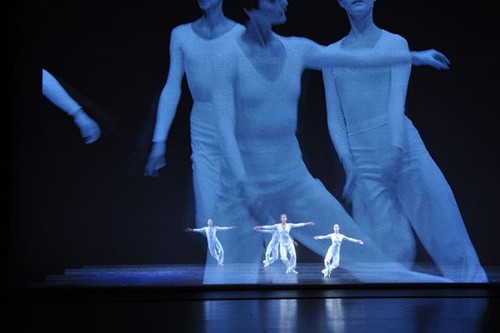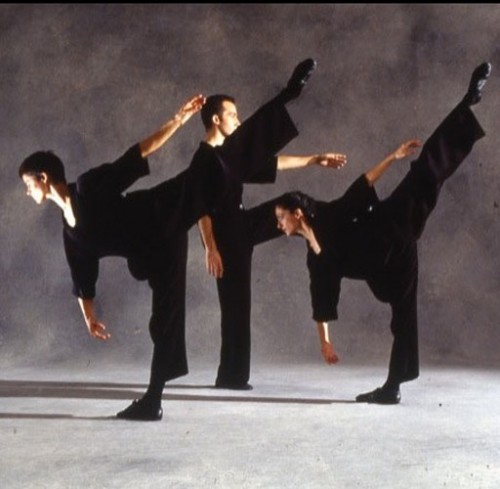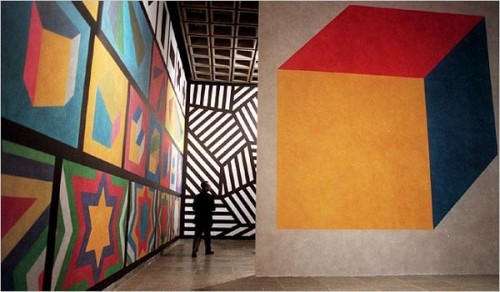Lucinda Childs' Offers Delightful Program at Williams College
Minimal Choreography Yields Maximum Pleasure
By: Ken Ross - Sep 26, 2009
WILLIAMSTOWN - Minimalism has never looked as beautiful as it looked Friday in Lucinda Childs' "Dance" at Williams College.
And if you want to see a true masterpiece by Sol LeWitt, forget MassMOCA. Run to the college today (Saturday, September 26) to see the second and final performance of "Dance," which features a film created by LeWitt to serve as scenery for the piece, which also contains another masterpiece by another minimalist master: composer Philip Glass.
Minimalism can often leave the viewer feeling cold. Sometimes, such an icy reserve can feel invigorating, like a crisp, clear winter morning. In the right setting, sculptor Donald Judd's simple, massive, box-like sculptures create such an awe-inspiring aura. Painter Agnes Martin's simple, graph-like drawings have a similar affect on a smaller scale. And for decades, Glass and fellow composer Steve Reich have been turning people on to minimalism with one hypnotic note after another.
But other times, minimalism can seem downright absurd or pretentious. Personally, LeWitt's critically-acclaimed, on-going exhibit at MassMOCA in nearby North Adams falls into this category. Maybe it's because the museum didn't give enough space to stand back and properly view these large-scale works. Or maybe it's the sheer repetition of the blocks of color on wall after wall. Whatever the reason, the paintings left me feeling as flat as the walls they're displayed on there.
LeWitt's dazzling film for "Dance" is an entirely different story. There's nothing complicated at all about the movie. In it, dancers dance practically the same steps the dancers dance live on stage behind a thin screen. Same goes for Glass' score to the 60-minute-long piece. The music features only a few musical notes played over and over throughout the three-part dance. But mix the music, the movie and the live dancers together and the result is a mesmerizing ode to motion.
Everything about the piece first performed in 1979 moves and feels alive. There's no plot, but everything on stage feels like it's constantly moving forward, like a steam train barreling ahead down the tracks. That's especially true with LeWitt's black-and-white movie. You can't take your eyes off the dancers as they dance across a large, white, chess-like grid. The filmed dancers often perform many of the exact same steps at the exact same time as the live dancers. But what makes LeWitt's movie so irresistible is he keeps constantly changing the perspective. We see the dancers in close up. Or we see them from above. Or head on. Or in tracking shots moving in unison with them. Or in fragments of film so the dancers appear to magically reappear on different parts of the grid like missing frames in a flip book.
Glass' propulsive music adds to the constant forward drive in "Dance." But Childs truly deserves a lot of credit for creating a dance with minimal choreography that yields maximum results. If Childs had not created such lyrical movements, the entire piece would have felt tedious and boring. Luckily, the dance created by Childs in "Dance" has a playful, energetic quality. The dancers seem to skip at times from one fluid motion into another. Several dancers were even spotted smiling as they danced around the stage.
The dancers' movements also feel reminiscent of a Jackson Pollock drip painting. The dancers move in constant, flowing lines that never seem to stop, like the sinuous strokes in one of Pollock's masterpieces. But unlike Pollock, Childs does not clutter the stage with seemingly random steps. Each dancer dances a precise series of simple yet elegant movements. There are no unnecessary parts. Every step counts.
Childs' "Dance" proves an old adage preached by many writers, particularly Ernest Hemingway and Raymond Carver. Less is more.
"Dance" will be performed today at 8 p.m. at Williams College's '62 Center for Theater and Dance. Tickets are $3 with valid student ID, $10 for all others. For more information, visit http://62center.williams.edu/62center/ For tickets, visit the Williams '62 Center Box Office today from 1 to 5 p.m. or call (413) 597-2425.
Ken Ross has written professionally about dance for more than a decade. He lives in Western Massachusetts. He can reached at kenrossnow@hotmail.com




